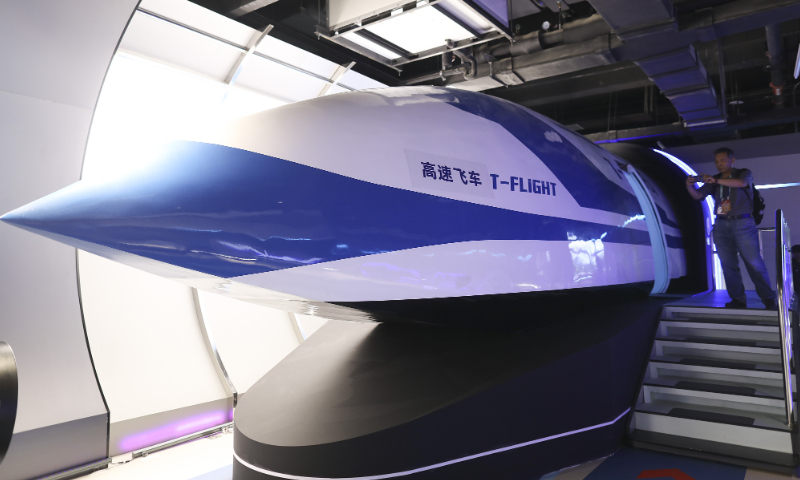
The photo taken on May 30, 2023 shows the "high-speed flying train" designed by China Aerospace Science and Industry Corporation. Photo: VCG
A project in China involving an ultra-high-speed low-vacuum tube maglev transport system, also known as the "high-speed flying train," with a maximum travel speed of 1,000 kilometers per hour, has completed a test for the system's integrated demonstration, showing that the full-sized test line has achieved conditions for its acceptance.
Representatives from the project said that this test improved the overall technical maturity of the system, laying a solid technical foundation for the next test, Science and Technology Daily reported on Monday.
The demonstration was conducted in a low-vacuum tube with a total length of 2 kilometers, the first phase of the project. The test performance and results were in line with predetermined figures, including magnetic suspension travel and brakes, maximum travel speed, and the magnetic suspension height of the vehicle, marking the success of the test.
The "high-speed flying train" may be deployed on commuter routes in mega-city clusters. It could shorten the travel time between Beijing and Shanghai to as little as 90 minutes, said the report.
The successful test indicated the concrete progress of the development of China's ultra-high-speed train, Sun Zhang, a railway expert at Shanghai Tongji University, told the Global Times on Monday. Long-term safety verification work needs to be implemented before it becomes a commonly used public transport system, Zhang said.
The full-sized test line was co-built by the government of North China's Shanxi Province and China Aerospace Science and Industry Corp, and it is located in Yanggao, under Datong. Construction started in April 2022 and wrapped up in November 2023. The project combines aerospace technology and ground rail transportation technology, aiming to create trains with a top speed of 1,000 kilometers per hour.
The concept of a transportation system in a low-pressure tube was proposed in 2013 by Elon Musk, who called it Hyperloop, but his company focusing on developing the system - Hyperloop One - was shut down at the end of 2023, Reuters has reported.
The official website of UK-based Virgin showed that its Virgin Hyperloop made its first successful passenger test in 2020.
Analysts said that it is hard to predict which country will be the first to operate a high-speed maglev train, but it is more practical to make such systems profitable in China, which has a huge population and a solid foundation in rail transport.
As of the end of 2023, the length of China's railways in commercial operation reached 159,000 kilometers, with more than 45,000 km of the total being high-speed lines, official data showed.




